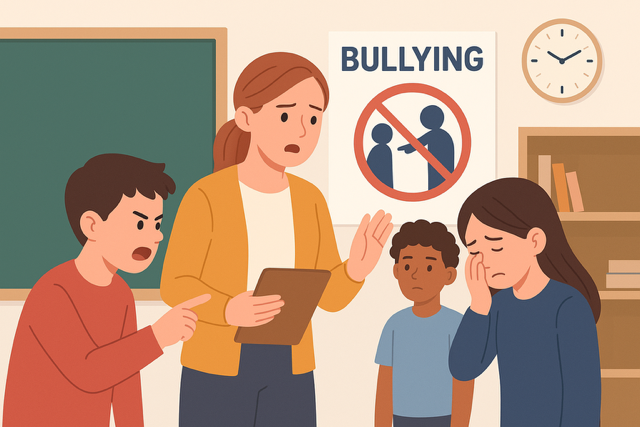
DISCOUNTED EDUCATION PRICING! CALL 1-877-891-8411. We Gladly Accept School Purchase Orders!

As an experienced educator with over two decades in the field, I’ve seen the profound impact bullying can have on students. From teaching in diverse settings, including urban public schools and suburban districts, I’ve learned that addressing bullying is about creating a classroom where respect and empathy are the foundation. In this in-depth guide, we’ll explore practical, evidence-based strategies for preventing and managing bullying in your classroom. Whether you’re a new teacher searching for “how to stop bullying in elementary school classrooms” or a veteran seeking “advanced techniques to foster a bully-free learning space,” this post draws from real-world experience and research to equip you with effective tools.
Bullying affects millions of students annually, with up to one in four reporting incidents during the school year, leading to long-lasting consequences. As teachers, we’re on the front lines, responsible for both academic instruction and social-emotional growth. Let’s dive into what bullying entails, how to identify it, and actionable strategies for teachers to handle bullying in the classroom.
Bullying is repeated, intentional behavior aimed at harming someone who struggles to defend themselves. It can manifest as physical aggression, verbal insults, social exclusion, or cyberbullying impacting the school day. In the classroom, bullying disrupts learning, erodes trust, and can lower academic performance for victims and bystanders.
Why prioritize “preventing bullying in classrooms tips for educators”? Unchecked bullying can lead to severe long-term effects. Research shows victims are twice as likely to suffer from anxiety, depression, and other health issues. Those who bully face risks like academic struggles, substance abuse, and violent behavior later in life. From my experience, early intervention transforms classrooms into safe havens where students thrive.
Recognizing bullying is the first step. Teachers often ask, “What are the subtle signs of bullying in school children that I might miss?” Based on my observations and expert guidelines, here are key indicators:
In my career, overlooking these signs as “kids being kids” was a mistake I learned to avoid. For example, a student avoiding recess was facing relentless name-calling. Prompt intervention turned things around. Bullying takes a huge toll on a students mental health.
As teachers, we’re not just educators but role models and guardians of classroom culture. “What is the role of teachers in preventing bullying in schools?” It starts with establishing authority through consistent, fair leadership. We set the tone by modeling respect, enforcing rules, and fostering inclusivity.
Research shows teachers who promote positive school climates significantly reduce bullying incidents. In practice, this means embedding anti-bullying education into daily routines, not just during awareness months. I’ve found empowering students to be upstanders—those who safely intervene—amplifies our efforts.
Prevention beats reaction for “preventing bullying in classrooms tips for educators.” Here are proven strategies I’ve successfully implemented:
These steps reduced bullying in my classrooms by fostering belonging. For instance, daily empathy exercises helped students self-regulate conflicts before they escalated.
When bullying occurs, swift action is key. Teachers ask, “How to respond to bullying in the classroom without escalating the situation?” Here’s a structured approach based on leading guidelines:
In one case, addressing social exclusion through restorative circles resolved the issue and strengthened class bonds.
Ignoring bullying leads to dire outcomes. “What are the long-term effects of bullying on students?” Victims may face PTSD, lower self-esteem, and social withdrawal into adulthood. Bullies risk criminal behavior, impulsivity, and reduced earning potential. By intervening, we promote healthier futures for all students.
To empower you further, here are answers to common questions:
How can I differentiate between teasing and bullying?
Teasing is mutual and light-hearted; bullying involves power imbalance and harm. If it persists despite requests to stop, it’s bullying.
What if the bullying involves cyber elements?
Monitor school-related online interactions and teach digital citizenship. Collaborate with IT staff to block harmful content.
How do I handle bullying from parents or staff?
Report to administration immediately, prioritizing student safety while maintaining professionalism.
Can anti-bullying programs really work?
Yes, schools with comprehensive programs see up to 25% reductions in bullying.
What resources are available for teachers?
Organizations like StopBullying.gov offer free toolkits and training.
Mastering “effective strategies for teachers to handle bullying in the classroom” demands more than vigilance, Empathy, and decisive action—it calls for a commitment to transforming your classroom into a sanctuary of respect and inclusion. As educators, we wield the unique power to shape not just academic outcomes but the social and emotional well-being of our students, creating ripple effects that extend far beyond the school year. By fostering a positive classroom culture, responding promptly to incidents, and empowering students to become upstanders, we lay the foundation for safer, more compassionate schools. Drawing from my extensive experience across diverse educational settings and supported by robust research, I urge you to embrace these strategies with urgency and purpose. Start today by setting clear expectations, building strong relationships, and modeling the respect you wish to see. Your classroom can be more than a place of learning—it can be a beacon of hope, a model for others, and a catalyst for change. Act now, and watch your students not only flourish but carry forward the values of kindness and courage into their futures.